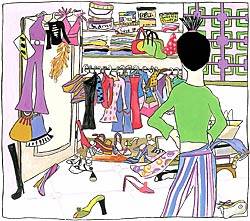The Boston Globe Magazine, September 15,
2002
Battle of the bulge Making space in the closet for the clothes you actually do wear.

Closets keep secrets. The good ones. The bad ones.
The hideous, the end-of-season-markdown, the doesn't-quite-fit-but-might-if-I-stick-to-the-Zone-Diet
ones. And unlike chatty friends or a misplaced journal, closets do not reveal their
secrets easily. In most cases, it would take a whole troop of investigators - a
sort of Law & Order fashion-victims unit, if you will - to piece together a person's
profile based on the contents of his or her wardrobe. Perhaps that's why the idea
of cleaning and reorganizing a clothes closet is so daunting. There's just too much
personal history to slog through. The too-short cocktail dress you wore to your
college roommate's first wedding. The size-4 leather pants you thought might fire
up a tepid relationship. (They didn't.) The red platform boots you regretted buying
the minute you walked out of the store. Purging a closet forces you to dredge up
failed relationships, yo-yo diets, lapses in taste. However, the alternative - an
endless struggle to make space for the clothes you actually do wear - is even worse.
Which brings us to the first step in organizing your closet - and your wardrobe
- this fall: Before you whip out your credit card and buy a stack of clothes, figure
out what you already have. The best way to do that? Pull everything out and take
stock. Yes, it's an arduous process, but a necessary one if you don't want to stare
at your old, frayed, ugly, out-of-date, or ill-fitting clothing purchases for the
next five years. What you'll quickly realize is that you tend to buy the same items
over and over again, depending on your style. (Especially if your closet is so crammed
you can't find anything.) If your taste runs to the traditional, you'll gravitate
to the rack of charcoal wool pants every year around this time. Sweater-set fans
keep buying shell-cardigan combinations. Those who prefer tailored skirts will inevitably
buy more of them. Trendy types: You'll tend to have less overlap from season to
season. On the other hand, the pieces you buy start to look dated sooner. Either
way, once you've hauled out all your clothing and organized it, you can start pruning
- or editing, as they call it in the fashion biz. This second step requires a detailed
examination of each piece. If an item is torn, stained, or simply not your style
anymore, toss it into the charity pile. (More on this in a moment.) If something
needs mending, toss it onto a repair pile (and commit to making the fix - otherwise,
you're better off getting rid of the item). Unless you're a diehard collector willing
to sacrifice an entire room to house clothing that's out of date, the idea of holding
on to your old garb because "someday it'll be back in style" is a nonstarter. If
you're not wearing it now, donate it to someone who will. By the way, most charitable
resale shops (Boomerangs in Jamaica Plain is a good one) aren't fussy about the
quality of the clothes that people drop off. For pricier items (your DKNY slacks,
perhaps?), a consignment shop may be the way to go. Second Time Around, one of the
best-known shops in the area, accepts high-end and designer items that are no more
than two years old. When one of your items sells, you're automatically sent a check
for 50 percent of the sale price, which makes parting with expensive items a bit
less painful. And you can even check the status of your consigned items on the store
chain's Web site, www.secondtimearound.net. "People love the Web site," says Jeff
Casler, who runs Second Time Around's Newbury Street location. (His mother, Dorothy,
opened the Newton location 30 years ago.) On the site, people can sign up for personal
accounts that track how much money they're due and how much they've received for
their consigned clothing. "People check their accounts all the time," says Casler.
"It's like tracking the stock market." Once you've gotten rid of the stuff you no
longer want, you can put everything else back in your (still tiny) closet. To squeeze
every inch of space you can out of it, installing a closet system - complete with
dividers, high and low rods for hanging, and small compartments for shoes, accessories,
and hats - may be what you need. Depending on how big the closet is to begin with,
a shelving system may only run you a few hundred dollars. And, to hear those in
the closet business tell it, such systems can increase the resale value of a house
or condo. Even better, you'll have room for all the new fall clothes you're about
to buy.